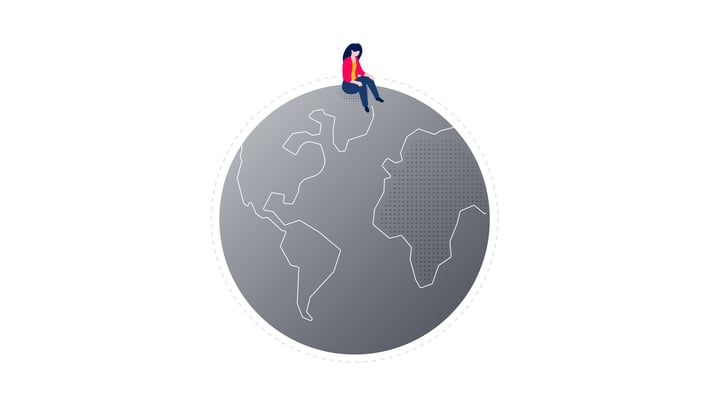Why Most Employees Are Lonely and Underperforming
Today’s workers are lonelier than ever before resulting in a disengaged, disloyal, and disenchanted workforce. Here’s what’s causing today's loneliness and the role inclusion plays in solving it.

If you’re feeling lonely, you’re not alone.
Sixty-one percent of American adults report they are lonely, a 7 percent increase since 2018. In addition, people are making fewer friends on the job. In 1985, half of people said they had a close friend at work. By 2004, less than a third did.
Among Generation Z workers aged 18-22, 73 percent report sometimes or always feeling alone, a 4 percent increase since 2019. The next generation entering the workforce is the loneliness of any other generation.
Loneliness is a growing health concern. Vivek Murthy, the former U.S. Surgeon General, estimates loneliness can shorten a person’s life by 15 years, equivalent to smoking 15 cigarettes per day or being obese.
Loneliness also represents an employee engagement and retention issue as half of Millennials and 75 percent of Gen Zers have left a job because of mental health reasons, compared with 34 percent of other generations.
The Modern Causes of Loneliness
Loneliness is the absence of connections. Someone who is surrounded by people may still feel lonely. A connected world that's leaving so many feeling disconnected is counterintuitive and yet it’s our new reality.
Here are a few reasons why humanity is experiencing more loneliness than ever before.
- Demanding Work: Today’s modern workers have a tendency to deprioritize relationships at work and instead focus on productivity and being professional.
- Dependency Shift: Information is no longer centralized in a family member, neighbor, or coworker. Information is decentralized, empowering humanity to seek knowledge and help individually via YouTube.
- Mobility: More mobility in where, when, and how we work has caused people to invest less in their relationships at work and in their community.
- Technology and Social Media: Technology can reduce quality human interactions through distractions and/or by substituting lower quality online connections. Very heavy social media users are significantly more likely to feel alone, isolated, left out and without companionship.
- Work Life Balance: If meaningful connections are reserved for outside of work, then today's always-on work culture leaves little to no time to pursue and cultivate meaningful connections.
- Immediacy: Today’s on-demand culture has left many people opting for swift transactional digital relationships over the delayed gratification of investing in long-term relationships
The Business Impact of Loneliness
"The trends shaping how we work – increasing use of technology, more telecommuting and the always-on work culture – are leaving Americans more stressed, less rested, spending more time on social media, and less time with friends and family," said David M. Cordani, President and Chief Executive Officer, Cigna. "For the business community, it is resulting in less engagement, less productivity, and lower retention levels."
Lonely workers are…
- Two times more likely to miss a day of work due to illness.
- Five times more likely to miss work due to stress.
- Twice as often to think about quitting their job.
- More inclined to believe their work is lower quality (12 percent).
- More likely to be remote workers.
For organizations to create a more engaged, productive, and loyal workforce, they must be mindful of worker loneliness. Since work is a profound place for people to create belonging, organizations and leaders have an unparalleled opportunity to provide people with a greater sense of acceptance, support and inclusion.
The Science of Loneliness
Humans are social creatures. We have a deep desire to be accepted, cared for and involved in meaningful community. These desires were (and continue to be) essential for our survival. Our ancestors who roamed the plains, lived in tribes where becoming separated or banished from the tribe made survival unlikely.
This explains why loneliness creates a psychological stress state in humans. And according to Murthy, “When we are lonely for a prolonged period of time that translates to a chronic stress state which leads to higher levels of inflammation in the body which damages blood vessels, tissues, and is the root of other health problems."
Additionally, during recent experiments neuroscientists recently discovered that people who were put through an experience of exclusion, their brain would light up and it was the same part of the brain that registers physical pain. Therefore being excluded is felt biologically the same as being physically hit. Even being excluded from a group that someone doesn’t respect is still harmful and creates pain.
The Significance of Inclusion
What often drives separation, isolation and exclusion isn’t difference, but distance.
Humans aren’t that different. In fact, the three things all humans are wired to do are survive, belong and become. These items are the hidden operating system running everyone's work and personal lives.
Humans, however, can be distant. When someone else's view, perspective or behavior is unknown, unfamiliar or unexplored, distance is created. Understanding and empathy grows with proximity. Abraham Lincoln once wisely said, “I don’t like that man, I must get to know him better.”
Busyness, distractions, hostility, immaturity, ignorance, efficiency, fear and selfishness can all contribute to the distance between people. If less loneliness and greater inclusion is the goal, move towards others and close the distance between people.
A powerful sense of belonging stems from the human desire to utilize one’s strengths, gifts, or talents to make a contribution that is valued by the team. Being needed reduces the risk of social abandonment, ultimately freeing people to do higher-level work.
As a generations keynote speaker and trainer, I help companies lead, work, and sell across generations. If you'd like help solving tough generational challenges inside your organization, click here.

